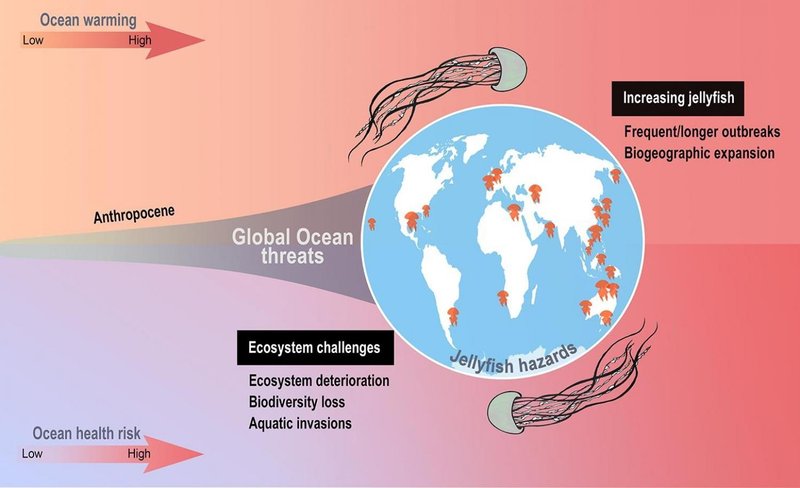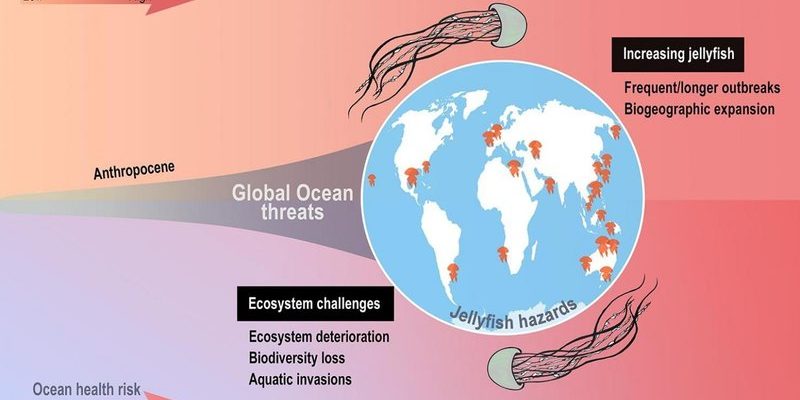
Honestly, jellyfish can seem simple, but they are incredibly ancient and resilient. They’ve existed for millions of years, adapting to various conditions in the seas. As our climate shifts—thanks to things like rising temperatures and ocean acidification—jellyfish are not just surviving; they’re thriving in some areas. Let’s dive into the many ways climate change is affecting jellyfish and what that means for our oceans.
Rising Ocean Temperatures
One of the most significant impacts of climate change is the rise in ocean temperatures. Warmer waters can be a boon for jellyfish populations. You might be wondering, how does this work? Well, jellyfish thrive in warmer waters because these temperatures often lead to an increase in plankton, their primary food source.
When the ocean heats up, it can create conditions that are perfect for jellyfish to reproduce. In many regions, we’ve seen *blooms*—massive gatherings of jellyfish that can take over vast areas. For example, in the Black Sea and the Mediterranean, there have been reports of jellyfish blooms doubling in size over just a few years. These blooms can disrupt local ecosystems, affecting fish populations and even tourism, as they can make swimming unpleasant.
What’s more, warmer seas can disrupt typical weather patterns. When ocean temperatures rise, it can lead to more hurricanes and storms, which can spread jellyfish populations to new areas. This means that even places that have never experienced a jellyfish problem are now facing potential blooms, making it a global concern.
Ocean Acidification
Along with rising temperatures, our oceans are becoming more acidic due to increased carbon dioxide (CO2) levels. This process, called ocean acidification, can affect marine life in unexpected ways. For jellyfish, however, they seem to be more resilient than many other species.
Here’s the thing: while many marine organisms struggle with the higher acidity—especially those with shells—jellyfish have a different structure. They are mostly made of water and have a gelatinous consistency that helps them cope with acidic conditions. In fact, studies have shown that jellyfish can actually thrive in more acidic environments, giving them a competitive edge over other species.
This resilience might allow jellyfish to spread even more widely as conditions worsen for many other marine animals. You might think of them as the *cockroaches of the ocean*, adaptable and ready to colonize new territories. As their numbers increase, they can disrupt the food web, showing just how interconnected marine ecosystems really are.
Changing Food Sources
With climate change comes altered ocean currents and shifts in nutrient availability. These changes directly impact the availability of phytoplankton, the fundamental food source in the marine food chain and, consequently, for jellyfish. In warmer waters, phytoplankton can flourish in some areas, while in others, the changes can lead to *dead zones*, regions where oxygen levels drop, making it hard for many marine creatures to survive.
For jellyfish, a sudden increase in phytoplankton due to nutrient runoff from land can lead to more food availability, which means they can reproduce and bloom at an accelerated rate. These changes create a new reality for both the jellyfish and the other species in their ecosystem.
In some regions, the shift in food sources may even allow jellyfish to compete more effectively against fish larvae for food. That means young fish might struggle to survive, and as their populations dwindle, the impact reverberates throughout the ecosystem. It’s a tricky balance, and jellyfish are finding themselves at the center of it all.
Impact on Marine Ecosystems
Jellyfish blooms can have profound effects on entire marine ecosystems. When these gelatinous creatures gather in massive numbers, they can consume vast amounts of plankton, which ultimately reduces the food availability for other species. Imagine a buffet where jellyfish are the only ones eating and all the other marine life are left hungry.
Additionally, large jellyfish blooms can lead to bycatch issues in fishing. Fishermen might inadvertently catch jellyfish instead of their target species, which can result in economic losses. In some cases, jellyfish can even clog fishing nets, causing more delays and complications.
And here’s an unexpected twist: as jellyfish become more abundant, they may influence the habitats of other species. Some fish, like sunfish, have started to adapt their diets to include more jellyfish. While that sounds fascinating, it’s a clear mark of how rapid changes can shake up long-standing ecosystems, making everything feel a little uncertain.
The Role of Human Activity
Human activity plays a significant role in these changes. Coastal developments, pollution, and overfishing contribute to conditions that favor jellyfish over other marine species. For instance, nutrient runoff from agriculture and sewage can stimulate phytoplankton blooms, which leads to more jellyfish food. This creates a feedback loop: the more nutrient pollution we cause, the more jellyfish thrive.
Additionally, warmer oceans due to climate change are often linked to other stressors like habitat destruction. For example, coral reefs, which provide essential habitats for many fish species, are declining. As reefs erode and disappear, jellyfish can take advantage of the alterations, filling the void left by the marine life we’re losing.
Understanding this interplay is crucial. By recognizing how our actions directly affect jellyfish population dynamics, we can start to make changes to protect marine ecosystems as a whole.
Future Implications
So, what does the future hold for jellyfish and our oceans? Well, predicting specific outcomes can be tricky. However, what we do know is that as temperatures rise and ocean conditions evolve, jellyfish are likely to become more prevalent in many bodies of water. This likely means more encounters with humans, who may find themselves swimming among jellyfish more often.
This could have serious implications for marine tourism and recreation. Coastal communities might see fewer fish and more jellyfish, making swimming and fishing less enjoyable. Additionally, jellyfish can also negatively impact power plants and other coastal industries by clogging intake pipes.
Ultimately, the increasing presence of jellyfish serves as a reminder of how interconnected our oceans are. Their ability to thrive amidst climate change highlights the need for drastic measures to protect marine environments. By focusing on reducing pollution and mitigating climate change, we might help restore balance—or at least slow the rise of these ancient ocean nomads.
In conclusion, climate change is reshaping the marine landscape in ways we’re only beginning to understand. The rise of jellyfish is both a fascinating and concerning phenomenon, serving as a bellwether for broader environmental changes. By staying informed and proactive, we can contribute to healthier oceans for all their inhabitants, jellyfish included.

